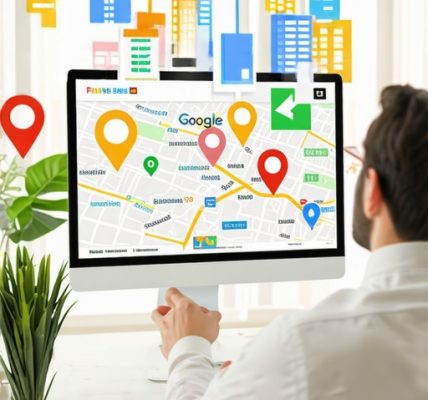Understanding Google Maps SEO for Local Businesses
In today’s digital marketplace, small businesses must harness the power of Google Maps SEO to enhance their visibility and attract local customers. Optimizing your presence on Google Maps not only helps you rank higher in local search results but also drives foot traffic to your physical location. This article delves into the top five Google Maps SEO tips that can elevate your local business growth.
1. Claim and Optimize Your Google Business Profile
The first step to effective Google Maps SEO is to claim and verify your Google Business profile. This profile serves as your business’s online storefront. Ensure that your profile is complete with accurate information, including your business name, address, phone number (NAP), and operating hours. A well-optimized profile improves your chances of appearing in local search results.
Importance of NAP Consistency
Maintaining consistency of your NAP across all online platforms is crucial. Discrepancies can confuse potential customers and negatively impact your local search rankings. Use tools like local SEO optimization to ensure that your information is uniform across directories and platforms.
2. Utilize Keywords Strategically in Your Business Description
Your business description is an excellent opportunity to incorporate relevant keywords. Include terms that your potential customers might use when searching for services or products you offer. For instance, if you run a florist shop, include phrases like “flower delivery” or “wedding bouquets”. This strategy enhances your chances of ranking higher in local searches.
Leveraging Google Business Categories
Select the most appropriate categories for your business. Google allows you to choose primary and secondary categories, helping search engines understand your business better. By accurately categorizing your business, you can improve your visibility in Google Maps search results.
3. Encourage and Manage Customer Reviews
Customer reviews are vital for building credibility and improving your local SEO. Encourage satisfied customers to leave positive reviews on your Google Business profile. Responding to reviews, whether they are positive or negative, shows that you value customer feedback and engagement.
Impact of Reviews on Local Rankings
Google considers the quantity, quality, and recency of reviews when determining your ranking. Therefore, actively managing your reviews can significantly enhance your visibility in local searches.
4. Add High-Quality Photos to Your Profile
Visual content plays a significant role in attracting customers. High-quality images of your products, services, and business premises can significantly enhance your Google Business profile. Customers are more likely to engage with a profile that features appealing visuals.
Using Photos for SEO Benefits
Regularly updating your photos can also help retain customer interest and signal to Google that your business is active. This activity can positively influence your search rankings.
5. Regularly Post Updates and Offers
Utilizing the posts feature on your Google Business profile allows you to share updates, offers, and events. Regular posting keeps your audience engaged and can improve your ranking in local search results. Posts that contain engaging content and relevant keywords can also enhance your overall SEO strategy.
Effective Posting Strategies
Engaging posts not only inform your customers but also encourage interaction, which is vital for local growth. Consider sharing seasonal promotions or community events to attract more local customers.
Implementing these Google Maps SEO tips can significantly boost your local business’s online visibility. By optimizing your Google Business profile, managing customer reviews, and actively engaging with your audience through posts and visuals, you can unlock the growth potential of your local business.
Leveraging Local SEO for Business Success
To truly harness the benefits of Google Maps SEO, local businesses must integrate local SEO strategies into their overall marketing approach. This means understanding the unique aspects of local search engine optimization, which is essential for attracting customers in your vicinity. Engaging with local audiences through targeted content and services can usher in remarkable growth opportunities.
Understanding Local Search Intent
Local search intent refers to the specific needs of users searching for products or services in their immediate area. By optimizing for local keywords, businesses can ensure they are visible to consumers at the moment they are looking to make a purchase. For instance, using phrases like “best coffee shop near me” or “affordable plumbing services in [your city]” can dramatically increase visibility.
6. Optimize for Mobile Users
With the rise of mobile usage, optimizing your website for mobile devices is crucial. Many customers search for local businesses using their smartphones while on the go. Make sure your website is mobile-friendly, fast, and easy to navigate. Google favors mobile-optimized sites in search results, making this an essential component of your local SEO strategy.
Importance of Mobile Usability
A mobile-friendly website enhances user experience, leading to longer visit durations and lower bounce rates. Utilize responsive design to ensure your site adjusts seamlessly across various devices. Tools like Google’s Mobile-Friendly Test can help you assess your site’s usability on mobile.
7. Implement Local Schema Markup
Schema markup is a code that you put on your website to help search engines return more informative results for users. Implementing local schema can provide search engines with specific information about your business, such as your address, business hours, and services offered. This can improve your chances of appearing in rich snippets in search results.
Benefits of Schema for Local SEO
By providing clear and structured information, schema markup can enhance your visibility in local search results and improve click-through rates. Use tools such as Google’s Structured Data Markup Helper to create and test your schema.
8. Build Local Citations
Local citations are online mentions of your business name, address, and phone number. They play a significant role in local SEO as they help search engines verify the legitimacy of your business. Ensure your business is listed in local directories, including Yelp, Yellow Pages, and industry-specific directories.
Maintaining Citation Consistency
Consistency is key when it comes to citations. Ensure your NAP (Name, Address, Phone number) is consistent across all platforms to avoid confusion among customers and search engines. Discrepancies can hinder your rankings. Use services like GMB citation services to help manage your listings effectively.
9. Collaborate with Local Influencers
Partnering with local influencers can boost your visibility and credibility within the community. Influencers can help promote your business through social media, blogs, and other platforms, driving traffic and potential customers to your Google Business profile.
Creating Engaging Content with Influencers
Work with influencers to create engaging content that resonates with your target audience. This could include blog posts, social media campaigns, or even events. Their endorsement can significantly enhance your local presence and trustworthiness, leading to increased customer engagement.
10. Monitor and Adapt Your SEO Strategies
Finally, it is crucial to regularly monitor your SEO performance and adapt your strategies accordingly. Utilize tools like Google Analytics and Google Search Console to track your website traffic, ranking, and user behavior. This data will help you identify what works and what doesn’t, allowing you to refine your approach.
Importance of Continuous Improvement
The digital landscape is always changing, and SEO is no exception. Stay updated with the latest trends, algorithm changes, and best practices in local business SEO. Continuous improvement is key to maintaining and enhancing your visibility in local searches.
11. Utilize Google Posts to Engage Your Audience
Google Posts allow you to share timely updates, promotions, and events directly on your Google Business profile. By regularly posting engaging content, you can keep your audience informed and encourage interaction. These posts appear in local search results and can directly influence customer decisions.
Creating Compelling Google Posts
When crafting Google Posts, ensure that you include relevant keywords that resonate with your target audience. For instance, if you’re running a special promotion, use terms like “limited-time offer” or “exclusive discount”. This not only grabs attention but also enhances your local SEO efforts.
12. Leverage Video Content for Enhanced Visibility
Video content is a powerful tool for engaging potential customers. Consider adding videos to your Google Business profile to showcase your products, services, or behind-the-scenes glimpses of your business. Videos can increase engagement and time spent on your profile, positively impacting your SEO.
Benefits of Video for Google Maps SEO
Search engines prioritize diverse content formats, and videos can help improve your rankings in Google Maps search results. Moreover, videos can convey information more effectively, making them a compelling addition to your marketing strategy.
13. Maintain a Strong Social Media Presence
Integrating your social media profiles with your Google Business listing can enhance your online presence. Ensure that your business profiles are linked and consistently updated with fresh content. This not only drives traffic to your website but also signals to Google that your business is active.
Social Media Engagement for Local SEO
Engaging with your audience on social media platforms can foster community and brand loyalty. Encourage followers to leave reviews and share your posts, which can contribute to your overall visibility on Google Maps.
14. Track and Analyze Your SEO Performance
Monitoring your SEO performance is essential for making informed decisions. Use tools like Google Analytics and Google Search Console to track traffic, user behavior, and conversion rates. Analyzing this data allows you to identify trends and adjust your strategies accordingly.
Utilizing SEO Metrics Effectively
Key performance indicators (KPIs) such as organic traffic, bounce rates, and conversion rates can provide insights into your Google Business SEO strategies. By understanding what works best, you can refine your approach and focus on tactics that yield the greatest results.
15. Engage with Your Local Community
Building relationships within your local community can significantly boost your visibility. Participate in local events, sponsor community activities, or collaborate with other local businesses. These efforts can generate buzz and increase your credibility.
Community Involvement and Local SEO
Engaging with your community not only enhances your brand image but can also lead to valuable backlinks from local news outlets or blogs, improving your overall authority and search rankings.
16. Focus on Voice Search Optimization
With the rise of voice search, optimizing your Google Business profile for voice queries is crucial. Many users now search for local businesses using voice commands, often phrased as questions.
Strategies for Voice Search Optimization
To optimize for voice search, include conversational keywords and phrases in your content. Answer common questions related to your business and ensure your website is mobile-friendly, as most voice searches are conducted on mobile devices.
17. Utilize Google My Business Insights
Google My Business provides insights that can help you understand how customers find your business. Analyzing this data can reveal how customers interact with your profile, which can inform your marketing strategies.
Making Data-Driven Decisions
Utilize the insights to enhance your local SEO strategy. By understanding customer behavior, you can tailor your offerings and marketing efforts to better meet their needs, ultimately improving your visibility in local search results.
18. Enhance Your Google My Business Listing with Attributes
Attributes are special features that can highlight specific aspects of your business, such as accessibility options or whether you offer outdoor seating. Adding relevant attributes to your Google Business profile can help you stand out in search results and attract more customers who are looking for those specific features. For example, attributes like “women-owned” or “wheelchair accessible” can help niche down your audience effectively.
Choosing the Right Attributes
When selecting attributes, consider your target audience and what they might be looking for. This allows you to tailor your offerings better and make your business more appealing to potential customers. Make sure to update these attributes regularly to reflect any changes in your business.
19. Engage with Customers through Q&A on Your Google Business Profile
The Q&A section on your Google Business profile offers a unique opportunity to engage with potential customers. Here, users can ask questions about your products or services, and you can provide timely responses. This interaction can have a positive impact on your local SEO by improving user engagement and showcasing your customer service skills.
Managing Q&A Effectively
To maximize this feature, proactively populate the Q&A section with common queries and their answers. This not only demonstrates your expertise but also helps potential customers find information quickly, enhancing their experience with your brand.
20. Utilize GMB Insights for Targeted Improvements
Google My Business Insights provide valuable data about how customers find and interact with your listing. By analyzing this data, you can uncover trends and areas for improvement in your Google Maps SEO strategy. For example, if you notice that a significant number of users are searching for your business through specific keywords, you can optimize your content to better align with those terms.
Making Data-Driven Adjustments
Regularly reviewing GMB insights allows you to make informed adjustments to your marketing strategy. Tailor your posts, photos, and responses based on the data to enhance your visibility and attract more customers.
21. Promote Your GMB Listing through Local Advertising
Consider investing in local advertising to promote your Google Business listing. Platforms like Google Ads can help you target local customers effectively, driving more traffic to your profile. Promoting your listing can significantly increase your visibility in the local search landscape.
Targeting the Right Audience
When running local ads, ensure you target the right demographics and geographic areas. Highlight promotions or special events to capture the attention of potential customers and drive engagement.
22. Regularly Update Your Google Business Profile
Keeping your Google Business profile updated with the latest information is crucial for maintaining relevance in local searches. Regular updates, including changes in services, hours, and special offers, help keep your audience informed and engaged.
The Importance of Fresh Content
Google favors active profiles, so frequently updating your content can improve your local SEO. Consider creating a content calendar to plan regular updates, ensuring your profile always reflects the latest offerings.
23. Collaborate with Other Local Businesses
Forming partnerships with other local businesses can enhance your visibility and credibility. Joint promotions or events can help both businesses reach a broader audience and improve their local SEO efforts.
Creating Win-Win Scenarios
By collaborating, you can create unique experiences for your customers that encourage them to visit both establishments. This not only boosts traffic but also strengthens community ties.
24. Stay Informed About Google Algorithm Updates
Being aware of changes in Google’s algorithms can help you adjust your local SEO strategy accordingly. Staying informed allows you to adapt your tactics and maintain or improve your rankings in local search results.
Continuous Learning and Adaptation
Join local business forums, attend workshops, or follow SEO blogs to stay up-to-date on best practices and algorithm changes. Continuous learning is essential for long-term success in local SEO.
Comprehensive FAQ Section on Google Maps SEO
What is Google Maps SEO and why is it important?
Google Maps SEO refers to the strategies used to optimize your business listing on Google Maps to enhance visibility in local search results. It is crucial because it helps local businesses attract more customers by appearing prominently when potential clients search for relevant services in their area.
How can I improve my Google Business profile ranking?
To improve your Google Business profile ranking, ensure that your profile is fully optimized with accurate NAP information, utilize relevant keywords in your business description, encourage customer reviews, and add high-quality images. Regularly engaging with your audience and posting updates also contributes significantly to ranking improvements.
What role do customer reviews play in Google Maps SEO?
Customer reviews are a vital ranking factor in Google Maps SEO. Positive reviews can enhance your business’s credibility, improve visibility, and influence potential customers’ decisions. Actively managing and responding to reviews can also boost engagement and further enhance your local search rankings.
How often should I update my Google Business profile?
Your Google Business profile should be updated regularly to reflect any changes in services, hours, or promotions. Frequent updates signal to Google that your business is active, which can positively affect your local SEO ranking.
Can using local keywords really affect my Google Maps ranking?
Yes, using local keywords in your business description and posts can significantly impact your Google Maps ranking. These keywords help Google understand your business’s relevance to local searches, increasing the likelihood of appearing in local search results.
What is local schema markup, and how does it help?
Local schema markup is code added to your website that provides search engines with precise information about your business, such as your location, services, and operating hours. Implementing schema can enhance your visibility in search results and improve click-through rates.
How do I track the performance of my Google Maps SEO efforts?
You can track your Google Maps SEO performance using tools like Google Analytics and Google My Business Insights. These tools provide data on how customers find and interact with your listing, helping you identify areas for improvement.
What strategies can I use to optimize for voice search?
To optimize for voice search, focus on using natural, conversational language in your content. Include long-tail keywords and phrases that potential customers might speak when searching for your services. Additionally, ensure your website is mobile-friendly, as most voice searches are conducted on mobile devices.
Is it necessary to have a website to succeed in Google Maps SEO?
While it’s not mandatory to have a website to be listed on Google Maps, having one can significantly enhance your SEO efforts. A website offers more space to showcase your services, and it can improve your credibility and visibility in search results.
What are the benefits of collaborating with local businesses for Google Maps SEO?
Collaborating with local businesses can enhance your visibility and credibility within the community. Joint promotions or events can help both businesses reach a broader audience, improving local SEO efforts through increased engagement and backlinks.
Conclusion: Unlocking the Potential of Google Maps SEO
In conclusion, mastering Google Maps SEO is essential for local businesses aiming to attract more customers and enhance their online presence. By implementing effective strategies such as optimizing your Google Business profile, managing customer reviews, and engaging with your audience, you can significantly boost your visibility in local search results. Remember, continuous improvement and adaptation are key to staying ahead in the ever-evolving digital landscape.
Recommended Literature for Expanding Knowledge
For those looking to deepen their understanding of Google Maps SEO and local search strategies, consider exploring the following trusted resources:
- Moz’s Beginner’s Guide to Local SEO
- Neil Patel’s Guide to Local SEO
- Search Engine Journal on Local SEO Trends
- Ahrefs on Local SEO Strategies
- BrightLocal’s Resources on Local SEO
These resources offer valuable insights and best practices for optimizing your Google Maps presence and enhancing your overall local SEO strategy.




I’ve recently started paying more attention to my Google Business profile based on the insights from this article. Claiming and optimizing it really has been a game-changer for my local bakery. One thing I’ve learned is the importance of the NAP consistency. At first, I had different addresses listed on various directories, which was confusing for customers. Once I ensured everything was uniform, I noticed a significant increase in customers walking through my door after searching for nearby bakeries!
Additionally, I started to leverage customer reviews by politely asking for feedback in my receipts. I also respond to every review, which has helped build trust with my customers. After adding high-quality photos, I could see more engagement with my listing.
Now, I’m experimenting with video content for social media and my Google profile. It’s exciting to see how these different strategies can intersect to create new opportunities for growth. Has anyone else experienced noticeable changes after optimizing their Google Business profile? Would love to hear more experiences!
Jessica, your experience really highlights the tangible benefits of optimizing a Google Business profile, especially regarding NAP consistency. I’ve found that while many local businesses focus heavily on adding keywords and photos, they sometimes overlook how critical accurate operating hours are. In my case, after correcting outdated hours and adding supplemental details like special holiday schedules, I noticed a decrease in customer inquiries about availability, which improved overall customer satisfaction and indirectly boosted our profile rankings. Also, actively managing the Q&A section has been useful for us; answering common questions right there prevents repetitive queries and shows prospects that we’re responsive. I’m curious, have you considered integrating local schema markup on your website as well? It’s a bit technical but can further solidify your business details in search results. How do you or others balance these behind-the-scenes SEO tactics with more visible efforts like reviews and postings? I’d love to hear different approaches to maintaining that balance in a busy local business environment.
Michael brings up an excellent point about the importance of accurate operating hours and how they influence customer satisfaction besides SEO. In my experience running a local service business, it wasn’t until I updated not only the standard hours but also the holiday schedules and added them clearly in our Google Business profile that we noticed fewer calls asking about availability and a smoother customer experience. That clarity seems to build trust before customers even walk in the door.
On balancing behind-the-scenes SEO tactics like local schema markup with more visible efforts such as managing reviews and posting engaging content, I approach it like maintaining both the backbone and the face of the business online. The technical side, while less visible, supports everything by making sure search engines understand the business fully, while reviews, photos, and posts actively invite customer interaction. Allocating time regularly between the two — maybe a couple of hours a week for schema and citations updates, alongside daily or weekly customer engagement — has worked well for me.
Has anyone else found effective ways to integrate these technical optimizations with customer-facing activities without overwhelming their workflow? I’d be interested to hear different strategies or tools that help streamline this balance.
Reading through this post, I realized how often I overlook the importance of just consistently updating my Google Business Profile. It’s easy to forget that these small, regular efforts — like adding fresh photos or posting new offers — can make a real difference in local search visibility. I think one of the overlooked aspects is how these updates also demonstrate to Google that your business is active, which can be a signal for higher ranking.
I’ve found that setting a weekly schedule for reviewing and updating my profile, especially before busy seasons or local events, helps me stay on top of this. Has anyone else found success with specific tools or routines that help keep these efforts manageable alongside running daily operations? Also, do you think that integrating other digital channels, like social media, with your GMB updates amplifies the impact?
It’s inspiring to see so many strategies working together to grow local presence—definitely something I want to focus more on in my own business. Would love to hear what routines others have found effective for maintaining consistency without it feeling overwhelming.